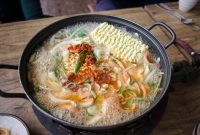
Exploring the culinary landscape of Majorca, an island in the Balearic archipelago, offers a rich tapestry of flavors that reflect its vibrant culture and history. Known for its stunning beaches and historic towns, this Mediterranean gem also has a gastronomic scene that’s a fusion of local ingredients and age-old traditions. Join us as we delve into Majorcan cuisine, highlighting must-try recipes in 2025 that capture the essence of this enchanting island.
The Rich Tapestry of Majorcan Cuisine
Majorcan cuisine is a delightful blend of fresh, local produce and traditional cooking methods. The island’s geographical position in the Mediterranean means you’ll find an abundant use of seafood, olive oil, and a variety of fresh vegetables and fruits. With influences from Roman, Moorish, and Catalan culinary traditions, the food here is both diverse and deeply rooted in tradition.
Must-Try Traditional Recipes in 2025
Sobrasada de Mallorca
Sobrasada is a quintessential Majorcan delicacy. This cured sausage, made with pork, paprika, and spices, is soft and spreadable, making it a perfect accompaniment to bread. In 2025, Sobrasada continues to be celebrated both locally and internationally for its rich flavor.
Ingredients:
- 1 kg of pork shoulder, coarsely minced
- 300 g of pork belly fat
- 60 g of sweet paprika
- 10 g of salt
- 5 g of black pepper
- Casings for stuffing
Preparation:
Mix all the ingredients thoroughly and let the mixture rest for 24 hours. Stuff the mixture into casings and let it cure for about 6 weeks in a cool, dry place. Once ready, Sobrasada can be enjoyed spread on crusty bread or used to add depth to various dishes.
Tumbet
Tumbet is Majorca’s answer to ratatouille. It’s a simple yet flavorful vegetable dish that’s a staple in homes across the island. With layers of eggplant, potatoes, and red bell peppers covered in rich tomato sauce, Tumbet is a celebration of local produce.
Ingredients:
- 2 large eggplants, sliced
- 3 medium potatoes, sliced
- 2 red bell peppers, sliced
- 500 g of tomatoes, chopped
- 4 cloves of garlic, minced
- Olive oil
- Salt and pepper to taste
Preparation:
Fry the eggplant, potatoes, and bell peppers in olive oil until golden. In a separate pan, cook tomatoes with garlic until they form a sauce. Layer the fried vegetables in a baking dish, pour the tomato sauce over, and bake for 30 minutes at 180°C (356°F). Serve warm, ideally as an accompaniment to meat or fish.
Frito Mallorquin
Frito Mallorquin is an iconic dish that epitomizes Majorcan cooking, known for its use of offal. Traditionally made with lamb or pork liver, it includes an array of vegetables and spices that enhance the dish’s complex flavors.
Ingredients:
- 500 g of lamb liver, cubed
- 2 potatoes, diced
- 1 red bell pepper, sliced
- 1 onion, sliced
- 1 bulb of fennel, sliced
- 3 cloves of garlic, minced
- Fresh thyme and bay leaves
- Olive oil
- Salt and pepper to taste
Preparation:
Fry the potatoes until golden. Set aside and fry the liver until browned, then add the remaining vegetables and garlic. Season with thyme, bay leaf, salt, and pepper. Once the vegetables are soft, add the potatoes back into the pan, stir, and serve hot.
Pa Amb Oli
A simple yet delightful dish, Pa Amb Oli literally means “bread with oil.” It’s a popular snack or light meal in Majorca, perfect for showcasing the island’s high-quality olive oil and fresh produce.
Ingredients:
- 4 slices of rustic bread
- Extra virgin olive oil
- 3 ripe tomatoes
- Sea salt
- Optional: cured ham or cheese
Preparation:
Toast the bread lightly. Rub with a cut tomato, allowing the juices to soak in. Drizzle generously with olive oil and sprinkle with sea salt. Add optional slices of cured ham or cheese for additional flavor. Serve immediately.
Ensaimada
No exploration of Majorcan cuisine is complete without the mention of Ensaimada, the island’s beloved pastry. Known for its spiral shape and delicate layers, Ensaimada is enjoyed for breakfast or dessert.
Ingredients:
- 500 g of strong flour
- 100 g of sugar
- 3 eggs
- 40 g of fresh yeast
- 100 ml of water
- 50 ml of olive oil
- 100 g of lard
- Powdered sugar for dusting
Preparation:
Dissolve the yeast in water and mix with flour, sugar, eggs, and olive oil to form a dough. Let it rise for about an hour. Roll the dough into a thin sheet, spread with lard, and roll into a spiral. Let it rise again before baking at 180°C (356°F) for 20-25 minutes. Dust with powdered sugar before serving.
Modern Influences and Sustainability
In 2025, Majorcan cuisine is experiencing a renaissance, with chefs reinterpreting traditional dishes with modern techniques while keeping sustainability at the forefront. Locally sourced ingredients are celebrated, and there is a growing emphasis on organic farming and reducing food waste.
FAQ
Q: What is the best time to visit Majorca for a culinary tour?
A: The best time to visit Majorca for a culinary experience is during the spring and fall. The mild weather and harvest seasons offer fresh produce and fewer crowds, making it ideal for exploring local markets and dining at traditional eateries.
Q: Are there vegetarian options available in Majorcan cuisine?
A: Yes, Majorcan cuisine includes several vegetarian-friendly dishes such as Tumbet, Pa Amb Oli with cheese, and various salads and vegetable dishes. The emphasis on fresh produce makes it easy for vegetarians to find delicious options.
Q: Can I find gluten-free food in Majorca?
A: While some traditional dishes contain gluten, there are many options for those following a gluten-free diet. Many restaurants in Majorca cater to dietary preferences and can offer gluten-free alternatives upon request.
Q: How is Majorcan Sobrasada different from other types of sausage?
A: Majorcan Sobrasada is unique due to its spreadable texture and sweet paprika flavor, distinguishing it from other cured sausages. It’s a protected regional product, meaning authentic Sobrasada is made specifically in the Balearic Islands.
Q: What is the significance of Ensaimada in Majorcan culture?
A: Ensaimada has a rich cultural significance in Majorca and is often enjoyed during festivals and special occasions. It’s a symbol of Majorcan hospitality and is frequently gifted to visitors as a taste of the island’s sweet traditions.
Conclusion
Exploring Majorcan cuisine is a journey through time where traditional recipes are cherished and new culinary innovations are celebrated. Whether indulging in a hearty dish of Frito Mallorquin or savoring the sweet layers of an Ensaimada, you’ll experience the unique flavors that tell the story of Majorca’s heritage. As the island continues to embrace sustainable practices and modern influences, its culinary offerings will undoubtedly delight visitors and locals alike in 2025 and beyond.


